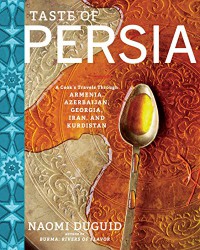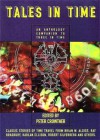Currently reading
Taste of Persia

by Naomi Duguid
This is a 400 page book with history and recipes for the food of an area that was once the Ancient Persian Empire, which includes modern Armenia, Azerbaijan, Georgia, Iran and Kurdistan. It is beautifully illustrated with full color pictures and a map, and has loads of travel information and history of the various countries in the region. The author traveled extensively through cities and villages in the different countries, picking up cooking methods and recipes along the way.
The first chapter is called Flavors and Condiments. It explains about basic ingredients like mint oil, spices, dried fruits, the use of an herb plate and the saffron crocus and how to use the strands in water. Recipes for mixtures of Persian salt and Svanetian salt are given along with often used items like Walnut sauce, apricot raisin relish and sour plum sauce.
The author explains that the history of the Zoroastrian religion still affects foods that are traditional to welcome the return of the sun at the Spring equinox, which I found culturally interesting.
Then we have a chapter on Salads and Vegetables. There are some familiar ingredients, like cucumber which seems to feature highly in this section, and less familiar items like pomegranate molasses, sumac and barberries. This is the one drawback to any ethnic cookbook, that some ingredients peculiar to the region might not be easily available everywhere.
The author suggests Persian food stores, which I assume can be found in a lot of cities but nor everywhere. Out of curiosity I looked on Ebay and found it very easy to get dried barberries, sumac and even the pomegranate molasses, although you have to be careful you don't accidentally order hookah tobacco in that flavor! As a result I've bookmarked a spice merchant who appears to have everything from smoked Paprika to szechuan peppercorns and ground black cardamom at very reasonable prices.
The vegetable chapter has a few variations of Borani, which is a favored dish of vegetables in yogurt sauce. They use eggplant, walnuts, and leeks in many of the recipes. There are also travel notes about places the author visited while researching the book interspersed among the recipes.
The next chapter is called Soup Paradise and has some interesting combinations like potato and pumpkin soup and herbed yogurt. There are also soups with meat, like Tabriz Meatball soup which sounds rather good and Kofta, which mixes dried fruits with meat and bean soups for the vegetarians.
Next is Stuffed Vegetables and Dumplings. This has such interesting delicacies as Eggplant roll-ups and Cabbage Dolmas, which is spiced meat rolled in cabbage leaves. This is followed by a chapter on fish, which you can have fried, stuffed, with fruit, in salad, or roasted with walnut paste.
Next is Grilled Meat and Poultry, with recipes for lamb, goat or beef kabab, perhaps pomegranate marinated with walnuts?
After an interlude for Fountains and Gardens, Picnics and Poetry, are some poultry recipes including roast chicken with fruits and walnuts and various chicken kebabs. Then in Stovetop Meat and Poultry we get recipes for Tart Lamb Stew with Fried Potatoes and an Easter Stew. I note that lamb seems to feature highly in stews. Kurdish Stew sounded interesting, flavored with cumin, turmeric and dried fruit, and can be made with lamb, beef or chicken. Spiced beef shank made with allspice, cardamom, cloves and cinnamon also caught my eye, although boiling meat has never been my favorite method. I may well try the spice mix on roasted instead.
A chapter on Rice and Other Grains includes Persian rice, made with yogurt and spices, and Kurdish Black Rice, made with pomegranate molasses. This one also gives a recipe for Polenta, which I've heard of before and can be bought in some supermarkets.
The chapter on Flatbreads gives recipes for basic flatbreads, Half-moon hand pies which look really good with various fillings; herb, vegetable or cheese. There are also cheese-filled pastries or quickbreads. The author gives us information about traditional breads from different regions like Persian Pebble bread or Barbari bread from Iran.
Then we have a chapter called A Taste For Sweet. The author explains that it's traditional to eat these sweet concoctions during the day for a snack rather than at the end of a meal. They include Rose water pudding and Persian Rice Pudding with cardamom and pistachios. The author says she substitutes pine nuts for the pistachios, but I can't imagine why! The original sounds so much better to me.
There are also recipes for Apricot-Walnut Pastry, Armenian Puff Pastry Cake with butter and cardamom, Date-Nut Halvah, Oasis Baklava, rose water and also some exotic teas and coffee with cardamom. They all sound generally more healthy than what we eat as sweet in the western world.
The last chapter, A Wealth of Fruit, has recipes for Fruit Leath, Peach Kompot, and some refreshing things to do with fruit juices. The book finished off with travel notes and a glossary, plus conversion charts after the index.
I'm not sure how many recipes I'll actually use out of this book, but reading it felt like going on a journey in exotic lands and experiencing the flavors that go with that region. It's certainly an enjoyable book to read and I'm glad the recipes were mostly kept in their original form. It gave me, as the title says, a real taste of Persia.
 1
1





